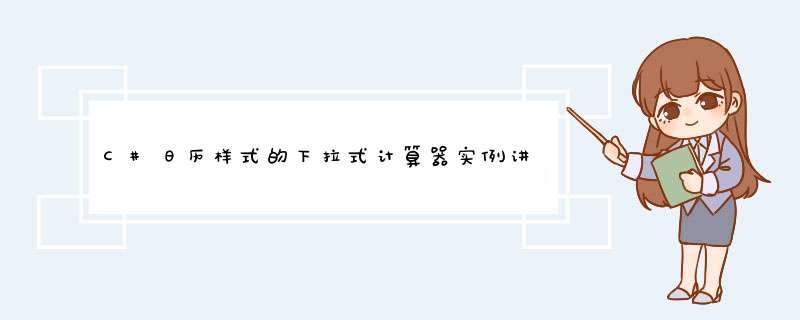
本文介绍了如何在Visual Studio中创建用户控件来显示下拉式计算器,d出效果类似于日历控件。
介绍
如果我们正在做一个类似于库存控制和计费系统的项目,有些部分可能必须手动计算数值。因此,用户就不得不使用计算器得到结果,再填入到输入字段中,或者在工作窗口上单独打开一个计算器窗口。总之,各种不便和麻烦。
这篇文章主要描述的是如何添加下拉式计算器到DataGrIDVIEw单元格中,如下图:
使用代码
第一步,我们必须先创建一个函数计算器,并且能够使用控件。因此,不妨先创建一个Visual Studio用户自定义控件。怎么做呢?打开VS,创建一个新的windows窗体应用程序(甚至你也可以在你当前的项目中这么做,但最好能分开,然后结合)。
然后,在Solution Explorer中,右键单击项目,选择add->User Control。命名(这里使用“CalculatorControl”),并添加。这时会给你一个像工作空间一样的windows窗体。在它上面,用控件工具箱中的TextBox和button创建一个计算器的布局。布局越小越好(想想日历控件),因为这就是个计算器而已。
为了快速搞定计算器功能,可以点击这里下载NCal(确保下载二进制文件),并添加到项目的引用文件中。
实现每个数字按钮的点击事件,将对应的数字输入/(追加)到文本框中,然后用同样的方式实现其他按钮,如+,X,/…并把对应的符号输入/(追加)到文本框中…
例如在文本框中输入:2 * 3 + 4
然后使用下面的代码来验证表达式,并得到结果:
// using Sy@R_502_6563@.windows.Forms; using ncalc; // string resText; bool eqpressed; double result; public voID btnEqual_Click(object sender,EventArgs e) { Expression ex = new Expression(textBox1.Text); if (ex.HasErrors()) { //InvalID Expression } else { result = Convert.Todouble(ex.Evaluate()); resText = result.ToString(); } textBox1.Text = resText; text = resText; eqpressed = true; } // 现在计算器功能已经完成。直接构建解决方案,那么你可能会发现用户控件显示在工具箱顶部。你可以添加windows窗体,拖放用户控件到窗体中运行,看看能否正常工作。
然后,在你想要添加下拉式计算器的项目中,创建另一个只有一个小按钮的用户控件。这个按钮将被用于打开计算器。
添加CalculatorControl内置引用文件到项目中。
创建一个新的继承toolstripdropdown的类:
using Sy@R_502_6563@.windows.Forms; class CalDrop : toolstripdropdown { Control content; ToolStripControlHost drop; public CalDrop(CalculatorControl content) { this.content = content; this.drop= new Sy@R_502_6563@.windows.Forms.ToolStripControlHost(content); //Add the host to the List this.Items.Add(this.drop); } } 在按钮的单击事件中添加以下代码:
private voID button1_Click(object sender,EventArgs e) { CalculatorControl calculator = new CalculatorControl(); CalDrop cal = new CalDrop(calculator); Point controlLoc = fm.PointToScreen(button1.Location); Point relativeLoc = new Point(controlLoc.X + button1.WIDth + 100,controlLoc.Y + button1.Height * 2); Rectangle calRect = button1.displayRectangle; cal.Show(locPoint); } 添加控件到DataGrIDVIEwCell
在你构建解决方案时,新的按钮控件会出现在工具箱中。添加以下代码到项目的窗体类中。
private CalculatorPick calculator; public form1() { calculator = new CalculatorPick(); calculator.Visible = false; dataGrIDVIEw2.Controls.Add(calculator); } private voID dataGrIDVIEw2_CellClick(object sender,DataGrIDVIEwCellEventArgs e) { if (e.ColumnIndex == clmCommision.Index) { Rectangle calRect = dataGrIDVIEw2.GetCelldisplayRectangle (e.ColumnIndex,e.RowIndex,false); Point p = calculator.FindForm().PointToClIEnt (calculator.Parent.PointToScreen(calculator.Location)); p.X -= calculator.WIDth/3; p.Y += calculator.Height; calculator.LocPoint = p; calculator.WIDth = calRect.WIDth/3; calculator.Height = calRect.Height; calculator.Visible = true; calculator.Calculator.btnEqual.Click += new EventHandler(calculatorBtnEqlClicked); } else if(calculator!=null) calculator.Visible = false; } voID calculatorBtnEqlClicked(object sender,EventArgs e) { dataGrIDVIEw2.CurrentCell.Value = calculator.Calculator.Result.ToString(); } 本技巧描述的是添加控件到DataGrIDVIEw中,可以让界面显得更为互动,喜欢的朋友就点个赞吧!
总结以上是内存溢出为你收集整理的C#日历样式的下拉式计算器实例讲解全部内容,希望文章能够帮你解决C#日历样式的下拉式计算器实例讲解所遇到的程序开发问题。
如果觉得内存溢出网站内容还不错,欢迎将内存溢出网站推荐给程序员好友。
欢迎分享,转载请注明来源:内存溢出

 微信扫一扫
微信扫一扫
 支付宝扫一扫
支付宝扫一扫
评论列表(0条)